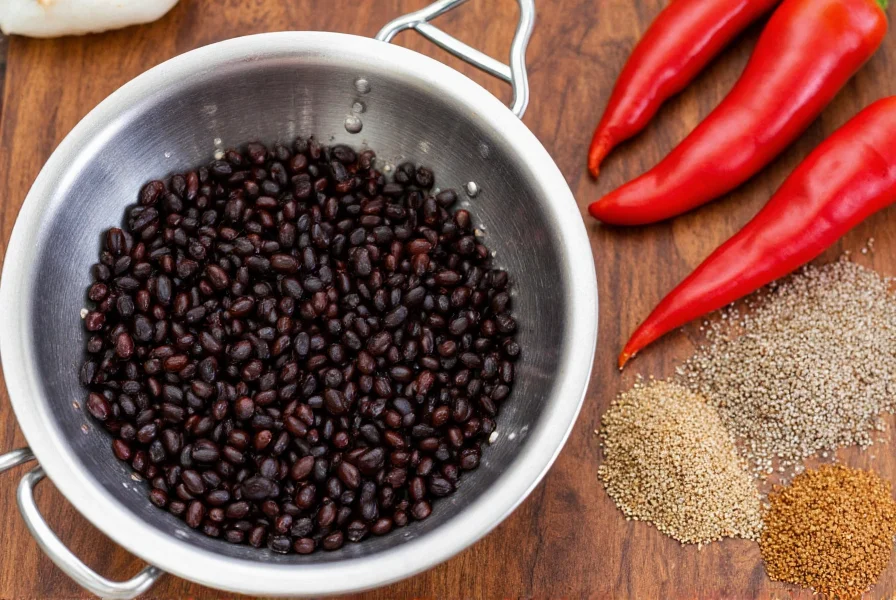When crafting the perfect pot of chili, bean selection plays a crucial role in determining texture, flavor absorption, and overall authenticity. Understanding which beans work best—and why—can transform your chili from ordinary to exceptional. This guide explores the top bean varieties for chili, their unique properties, and how to use them effectively in your recipes.
Why Bean Selection Matters for Chili
Beans aren't just filler in chili—they contribute significantly to the dish's texture, mouthfeel, and ability to absorb flavors. The right beans maintain their integrity during long simmering times while complementing the spices and meats in your recipe. Different bean varieties have distinct starch contents, skin thicknesses, and flavor profiles that interact uniquely with chili's complex seasoning.
Top Bean Varieties for Chili
Kidney Beans: The Classic Choice
Kidney beans are arguably the most traditional choice for chili, particularly in Midwestern and Cincinnati-style recipes. Their deep red color creates visual contrast against the brown tones of meat-based chili, while their slightly sweet, earthy flavor stands up well to bold spices.
What makes kidney beans ideal for chili:
- Thick skins that maintain shape during extended cooking
- Meaty texture that complements ground beef or turkey
- Excellent flavor absorption without becoming mushy
- Traditional inclusion in most canned chili products

Pinto Beans: The Authentic Option
Pinto beans are the preferred choice for many traditional Southwestern and New Mexican chili recipes. When cooked, their speckled beige shells transform into a uniform pinkish-brown color that blends seamlessly with chili's earthy tones.
Advantages of pinto beans in chili:
- Creamier texture that helps thicken chili naturally
- Earthy, nutty flavor that enhances rather than competes with spices
- Traditional inclusion in authentic regional chili recipes
- Versatile for both vegetarian and meat-based chili
Black Beans: The Flavorful Alternative
Black beans offer a distinct option for chili, particularly in Tex-Mex and vegetarian variations. Their dense texture and slightly sweet flavor create a different profile than traditional chili, but one that many cooks prefer for its complexity.
Benefits of black beans in chili recipes:
- Firm texture that holds up exceptionally well to long cooking
- Slightly sweet flavor that balances spicy elements
- Rich in antioxidants and nutrients
- Creates visually striking contrast in white or turkey chili

Regional Variations in Bean Usage
Chili traditions vary significantly by region, and bean preferences follow suit:
| Region | Bean Preference | Notable Characteristics |
|---|---|---|
| Texas | No beans (traditionally) | Pure meat stew focused on beef and spices |
| Cincinnati | Kidney beans | Served over spaghetti with unique spice profile |
| Southwest | Pinto beans | Authentic regional choice with earthy flavor |
| Midwest | Kidney or pinto beans | Hearty, family-style chili with beans |
Cooking Tips for Perfect Beans in Chili
How you prepare your beans significantly impacts your final chili. Follow these professional tips for best results:
Using Dried vs. Canned Beans
While canned beans offer convenience, dried beans generally provide superior texture and flavor control:
- Dried beans: Soak overnight, then partially cook before adding to chili (about 30-40 minutes)
- Canned beans: Rinse thoroughly to remove excess sodium and canning liquid
- Timing: Add beans during the last 30-60 minutes of cooking to prevent mushiness
Avoiding Common Bean Mistakes
Prevent these frequent errors when using beans in chili:
- Adding beans too early (results in disintegration)
- Using acidic ingredients too soon (prevents proper softening)
- Over-salting during cooking (causes toughening)
- Mixing different bean varieties without considering cooking times
Specialty Chili Bean Combinations
For creative variations, consider these bean combinations:
- Traditional Blend: Equal parts kidney and pinto beans for balanced texture
- Three-Bean Chili: Kidney, pinto, and black beans for complexity
- White Bean Chili: Cannellini or Great Northern beans with chicken or turkey
- Southwestern Style: Black beans with corn and chipotle peppers
When to Omit Beans Entirely
Authentic Texas-style chili con carne traditionally contains no beans. This meat-forward approach focuses on the quality of beef and depth of spice blend. If pursuing this style, consider serving beans on the side rather than incorporating them into the chili itself.
Final Recommendations
For most home cooks seeking the best beans for chili, kidney beans provide the classic texture and appearance most associated with traditional chili. Pinto beans offer a more authentic Southwestern option with their earthy flavor, while black beans create a distinctive profile perfect for Tex-Mex variations.
Remember that personal preference plays a significant role—experiment with different beans and combinations to discover your ideal chili profile. The best beans for chili ultimately depend on your regional preferences, dietary needs, and desired texture.
Frequently Asked Questions
What are the best beans for traditional chili?
Kidney beans are considered the best for traditional chili due to their meaty texture and ability to hold shape during cooking. Pinto beans are also excellent for authentic Southwestern-style chili with their earthy flavor profile.
Do you have to put beans in chili?
No, beans are not required in chili. Traditional Texas-style chili con carne contains no beans, focusing instead on meat and spices. Many regional variations include beans, but it's ultimately a matter of personal preference and regional tradition.
How do you keep beans from getting mushy in chili?
To prevent beans from becoming mushy in chili, add them during the last 30-60 minutes of cooking. If using dried beans, partially cook them separately before adding to the chili. Avoid adding acidic ingredients like tomatoes too early, as this prevents proper softening.
Can you mix different beans in chili?
Yes, mixing beans in chili can create interesting texture and flavor combinations. A popular blend combines kidney and pinto beans for balance. For more complexity, try a three-bean mix with kidney, pinto, and black beans, but be mindful of different cooking times for dried varieties.











 浙公网安备
33010002000092号
浙公网安备
33010002000092号 浙B2-20120091-4
浙B2-20120091-4